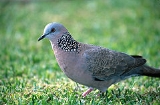
Columbiformes
Encyclopedia
Columbiformes are an avian
order
that includes the very widespread and successful doves and pigeons, classified in the family
Columbidae, and the extinct Dodo
and the Rodrigues Solitaire
, long classified as a second family Raphidae
. 313 species, found worldwide, comprise the Columbiformes order. Like many birds, all Columbiformes are monogamous. Unlike most other birds, however, they are capable of drinking by sucking up water, without needing to tilt the head back.
(sandgrouse) were formerly included in this order largely due to this drinking behavior ("The only other group, however, which shows the same behavior, the Pteroclididae, is placed near the doves just by this doubtlessly very old characteristic."); more recently, it had been reported that they cannot drink by "sucking" or "pumping", and they are now treated separately in the order Pteroclidiformes and are considered to be closer to the shorebirds.
Osteology
and DNA sequence
analyses indicate that the Dodo
and Rodrigues Solitaire are better considered as a subfamily Raphinae in the Columbidae pending availability of further information.
Bird
Birds are feathered, winged, bipedal, endothermic , egg-laying, vertebrate animals. Around 10,000 living species and 188 families makes them the most speciose class of tetrapod vertebrates. They inhabit ecosystems across the globe, from the Arctic to the Antarctic. Extant birds range in size from...
order
Order (biology)
In scientific classification used in biology, the order is# a taxonomic rank used in the classification of organisms. Other well-known ranks are life, domain, kingdom, phylum, class, family, genus, and species, with order fitting in between class and family...
that includes the very widespread and successful doves and pigeons, classified in the family
Family (biology)
In biological classification, family is* a taxonomic rank. Other well-known ranks are life, domain, kingdom, phylum, class, order, genus, and species, with family fitting between order and genus. As for the other well-known ranks, there is the option of an immediately lower rank, indicated by the...
Columbidae, and the extinct Dodo
Dodo
The dodo was a flightless bird endemic to the Indian Ocean island of Mauritius. Related to pigeons and doves, it stood about a meter tall, weighing about , living on fruit, and nesting on the ground....
and the Rodrigues Solitaire
Rodrigues Solitaire
The Rodrigues Solitaire was a flightless member of the pigeon order endemic to Rodrigues, Mauritius. It was a close relative of the Dodo.-Discovery:...
, long classified as a second family Raphidae
Raphidae
The Raphinae are a subfamily of extinct flightless birds colloquially called didines or didine birds. They inhabited the Mascarene Islands of Mauritius and Rodrigues, but became extinct through hunting by humans and predation by introduced non-native mammals following human colonisation in the 17th...
. 313 species, found worldwide, comprise the Columbiformes order. Like many birds, all Columbiformes are monogamous. Unlike most other birds, however, they are capable of drinking by sucking up water, without needing to tilt the head back.
Taxonomy
The PteroclididaeSandgrouse
The sandgrouse are a family, Pteroclididae, of 16 bird species, the only living members of the order Pteroclidiformes. They are restricted to treeless open country in the Old World, such as plains and semi-deserts. They are distributed across northern, southern and eastern Africa as well as...
(sandgrouse) were formerly included in this order largely due to this drinking behavior ("The only other group, however, which shows the same behavior, the Pteroclididae, is placed near the doves just by this doubtlessly very old characteristic."); more recently, it had been reported that they cannot drink by "sucking" or "pumping", and they are now treated separately in the order Pteroclidiformes and are considered to be closer to the shorebirds.
Osteology
Osteology
Osteology is the scientific study of bones. A subdiscipline of anatomy, anthropology, and archeology, osteology is a detailed study of the structure of bones, skeletal elements, teeth, morphology, function, disease, pathology, the process of ossification , the resistance and hardness of bones , etc...
and DNA sequence
DNA sequence
The sequence or primary structure of a nucleic acid is the composition of atoms that make up the nucleic acid and the chemical bonds that bond those atoms. Because nucleic acids, such as DNA and RNA, are unbranched polymers, this specification is equivalent to specifying the sequence of...
analyses indicate that the Dodo
Dodo
The dodo was a flightless bird endemic to the Indian Ocean island of Mauritius. Related to pigeons and doves, it stood about a meter tall, weighing about , living on fruit, and nesting on the ground....
and Rodrigues Solitaire are better considered as a subfamily Raphinae in the Columbidae pending availability of further information.

